User Activation
What is User Activation?
User activation describes the moment when a user first discovers the core value of your product. It’s an important part of your product onboarding process, as it defines when a user shifts from being a visitor to an active participant in your product or service.
When a user first lands on your product, they are merely just explorers checking out what you offer. Imagine them as settlers discovering new land. They’re looking to see if this place is worth sticking around in. While stumbling around the landscape, they’re not active yet, and can easily turn around, jump back on their ship, and leave. However, once they dig into the soil and find that this land has gold, they’re suddenly encouraged to stay put. They’ve seen what this area offers and are now activated.
As a Product Manager, you need to show these users that your product is a goldmine early on. You need them to discover the value of your product or feature as soon as possible. The quicker you can achieve user activation, the better.
But user activation isn’t one specific thing for everyone. In fact, it changes depending on the service you provide and your industry. For example, an eCommerce platform may define its user activation as the moment someone adds an item to their shopping cart. For a social media platform, user activation may be when a visitor follows their first account. Essentially, the moment you achieve user activation depends on what task you want your users to perform that demonstrates that they’ve found the value in your product.
User activation is a crucial metric, as it demonstrates that a user has not only grasped how to use your product but that they’ve also seen the value the product provides firsthand. This can help grow customer engagement, your adoption rate, and your conversion rate.
How is User Activation different from User Acquisition?
User acquisition and user activation measure two different points in the buyer’s journey. User Acquisition comes first, and activation comes later. Users are considered acquired when you bring them over to your platform; when a user signs up and makes an account. These users can still drop off. They’re not invested or committed to your product yet.
Activated users are the ones who have completed an action that demonstrates the core value of your product. They’ve had that light bulb moment that makes them think “Oh, this product is pretty cool, let’s see what else it can do”. Essentially, you want to turn acquired users into activated ones.
When activated, these users are more likely to become customers and continue to use your service. User acquisition is getting people to come to the party. Activation is when they buy a drink and stick around.
Both of these are pirate metrics 🦜, also known as AARRR metrics. This stands for Acquisition, Activation, Retention, Referral, and Revenue and are five user-based metrics that businesses should be tracking. Developed by Dave McClure (not Blackbeard), this was created to help businesses focus on metrics that matter.
What’s the difference between User Activation and The Wow Moment?
User activation and the wow moment are quite heavily linked. They both represent a moment when the user finds the value in your product. In fact, for user activation to happen, the user needs to achieve that wow moment.
The wow moment, also known as the aha moment, is when a user starts to get what’s great about your product. It’s a moment of clarity where the user starts to appreciate the benefits of your product more deeply.
Although extremely similar, there are subtle differences between the two. The wow moment is more emotional and perceptual. It’s a feeling users get that makes them think that your tool is going to be a great product. User activation is more concrete. It’s a milestone that users hit that signifies that they’re experiencing the best of what your tool has to offer. The user has performed a task to demonstrate the value of the product. As a result, user activation can actually be measured.
Here’s an example of the two for a Product Management tool like ProdPad:
- Wow moment: Users see all the different features and learn how they can make them better Product Managers.
- User Activation: A user creates their first Idea and saves it into their roadmap.
Discover the value of ProdPad with a free trial.
Why is User Activation important?
The first time a user tries out your product is like the first date in a relationship—if it doesn’t go well, there might not be a second one. As a Product Manager, you know that getting users to sign up is just the first step; the real magic happens when they start using and loving the product.
User activation is that pivotal moment when a new user experiences the value of your product for the first time, and it’s what turns casual sign-ups into committed users. If they don’t reach this point, users are likely to turn their back on your product and move on to something else, leaving you wondering what could have been.
But why is user activation so important? Think of it as the gateway to all the good stuff—like retention, customer loyalty, and even word-of-mouth referrals. Activated users are the ones who stick around, explore more features, and eventually become your biggest advocates. They’re the people who “get” your product and see why it’s worth their time (and money).
When you focus on user activation, you’re not just increasing the chances of users staying; you’re also setting the stage for faster time to value, lower churn rates, and a more predictable revenue stream.
So, if you want your product to thrive, user activation isn’t just important—it’s essential. It’s the difference between a user who casually strolls through your product and one who sets up camp and makes themselves at home.
How do you measure User Activation?
The first step in measuring user activation is to first decide when a user is considered activated. That, my friend, is down to you and what you believe your product value is. You set the trigger that demonstrates that a user has moved from the acquired phase to the activated phase.
For example, for the foreign language tutoring app Duolingo, a user may be considered activated after they’ve taken their first lesson. Once a user has experienced the core functionality of your product, app, or feature, then bingo, we’ve got liftoff 🚀.
Once you’ve decided what it is that makes a user activated, you can then track your user activation rate. This is a percentage that shows you how many users have completed your activation task. To find your rate for a specific period, divide the number of users who have reached the activation stage by the total number of sign-ups. Then, multiply this by 100 and tack on a percentage sign.

Let’s plug in some numbers to give you an example. Let’s say you’ve managed to acquire 2830 sign-ups for your product in the last month. Out of those, 470 have reached the activation milestone within that time period. By dividing 470 by 2830, and then multiplying it by 100, you get a user activation rate of 16.6%.
The question now is, is that any good?
What is a good User Activation rate?
This might seem like we’re dodging the question, but much like many things in Product Management, it depends. Things are far more nuanced than just aiming for an arbitrary number. The ideal user activation rate can vary significantly depending on the industry, product type, target audience, and pricing model.
For example, a B2B SaaS product with a complex onboarding process might have a lower activation rate compared to a consumer app with a simpler, more intuitive interface. Therefore, while 25%-30% might be strong for some, it’s not a one-size-fits-all metric. If you’re running a freemium pricing model to get users onboard, then you’ll likely be aiming for a lower activation rate than if you were offering free trials or tiered pricing. You can learn more about how to price a product below 🔽.
A good user activation rate also depends on your past performance. If you’ve constantly hit an activation rate of around 18%, then a jump to 25% indicates a good user activation rate for your specific circumstances. You always want your metrics to be better than your last, so when measuring your user activation, aim to improve on your last measuring period’s performance.
Just a heads up, as you look to improve your activation rate, you may start to encounter diminishing returns. As your activation rate increases, it becomes harder to continue improving it at the same rate. This is a natural occurrence in many metrics. You may find it easier to increase a low activation rate by 10%, but once you start hitting good numbers, raising it by 2% or so many start to feel like a huge struggle. Initial improvements are more significant, but anything after that takes more effort and resources.
It’s like the newbie gains you get when you go to the gym for the first time. You’ll get stronger quicker in your first few weeks, then hit a plateau where it takes longer to grow. That’s why setting realistic expectations for improvement is important 💪.
How do you increase your User Activation?
The best way to improve your user activation is to take a look at your product onboarding and how you first introduce new users to your product. During this process, there are many things you can do to give yourself a better chance of activating users early on and convincing them to become long-lasting customers of your product.
You can do this by building a better product tour or by creating a more seamless onboarding flow with the best user onboarding software tools. Some of the tactics you can follow include:
Streamlined onboarding
You don’t want new users to spend an age going through educational material while getting on board with your product. If this process takes too long, users can become bored and abandon it, meaning they’ll never reach the activation point and discover the value of your product.
When onboarding, your goal is to get users to reach the “wow moment” as early as possible. You need your onboarding to be swift and smooth. Don’t get bogged down in the details; just showcase the core features and functionality of your product.
By working on making the process user-friendly and eliminating redundant steps, you’ll help boost your user activation rate.
Personalization
Users resonate with products that are tailored to them and their needs. By adding personalization, you improve your chances of activating your users.
A generic onboarding process that’s the same for everyone may not work as well as onboarding flows that have been segmented based on your customer profiles. By tailoring the experience based on user needs, preferences, and behaviors, you can show features that are more relevant to each user. This highlights the specific value proposition to them, making them more likely to reach their “wow moment” and become activated users.
User education
If your user knows what they’re doing within your product, they’re more likely to become activated. When onboarding, focus on teaching your users about the features, functionalities, and potential of your product through video tutorials, FAQs, in-app tooltips, and more. By arming your users with knowledge, they’re empowered to explore your tool and meet your user activation criteria.
One of the best ways to effectively educate your users is through a product tour. You can learn how to build the best product tour possible through the link below 👇.
Incentivization
Providing incentives can push users toward activation. By giving users an additional reason to do something, you can further encourage them to perform a desired action. You can incentivize through discounts to create more reasons for users to become full-paying customers, or you can provide rewards for when users complete certain desired actions.
Email nurturing
Even once your onboarding is complete, keeping users engaged through your marketing is crucial to driving them toward activation. Email nurturing campaigns are an effective way to maintain contact with your users, especially if they’ve become inactive after completing their onboarding process.
By using a series of well-timed automated email flows that include tips, feature highlights, and other valuable content, you’re reminding users of the benefits of your product. This nudges them toward performing key actions that lead to activation. When sending your emails, include links and call-to-actions to invite users back onto your product.
Gamification
Everyone loves to play. Gamification makes use of game-like elements to make the user experience more engaging and rewarding. By introducing challenges, progress tracking, achievements, and rewards, you can motivate users to explore more features and complete necessary actions that lead them to your activation criteria.
For example, you can create a system where users earn points or badges for completing certain tasks or reaching milestones within the product. This not only makes the process more enjoyable but also gives users a sense of accomplishment, driving them to continue engaging with your product until they reach user activation.
User Activation examples
Looking for some inspiration? Here’s a closer look at some good examples of how real-world companies achieve user activation during their onboarding process. Many of these examples use different tactics to show off the value of their product and get their users to complete an action that triggers their activation. These efforts foster customer retention and help new users become lifelong customers.
Asana
Asana is a great example of using personalization to move users down the customer journey and make them activated users. By segmenting customers during the onboarding process, Asana can direct users to the most relevant features for them, helping them to discover the value of the product. They first do this by asking about your role and industry, as well as your main objectives for using the tool.
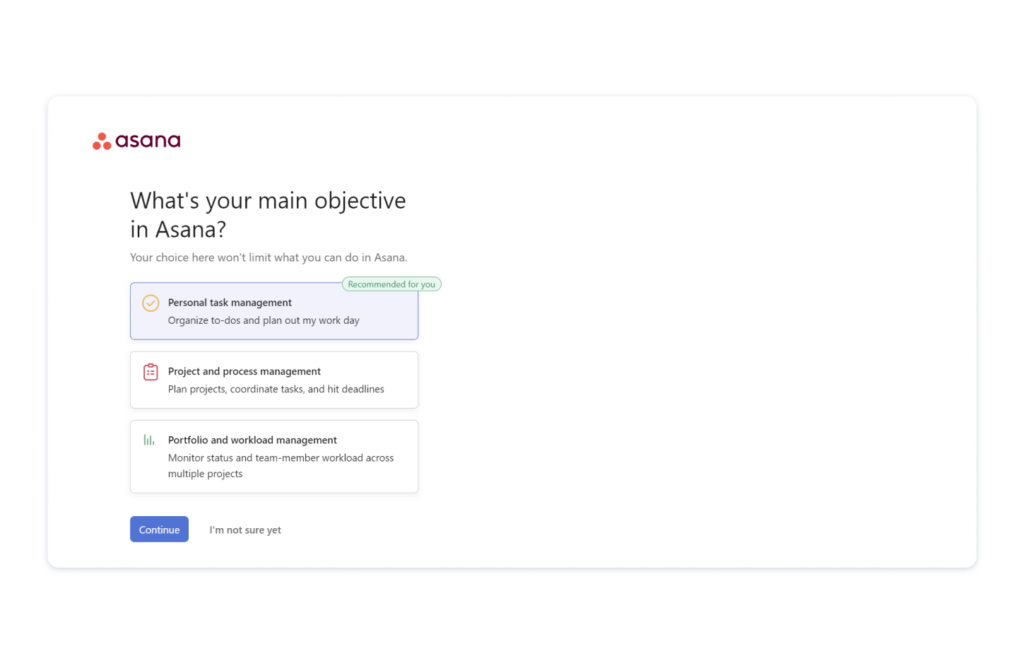
Following that, Asana then prompts you to input some of the tasks you’re working on so that the tool help better manage and track your progress. This step engages you with the product and gets you to start using the functionality straight away. The preview of the tool also gives users an insight into the UI of the tool and how it works around their tasks.
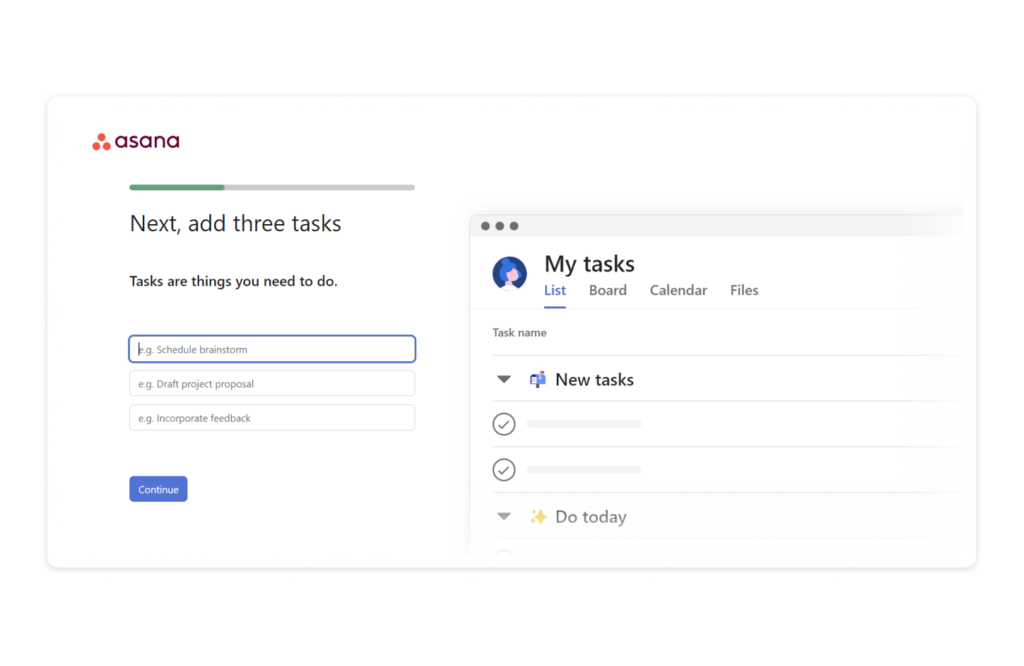
This personalization makes it easier for Asana to present the most relevant features and product information and hide any features that might not be as helpful to streamline the experience. Having a tailored tool drives users to explore it, making them more likely to complete the activation criteria.
Duolingo
Duolingo uses gamification to encourage users to complete their onboarding and become activated users by completing their first lesson. From the get-go, users are immediately thrown into their first lesson, helping them to experience first-hand the value of language learning app.
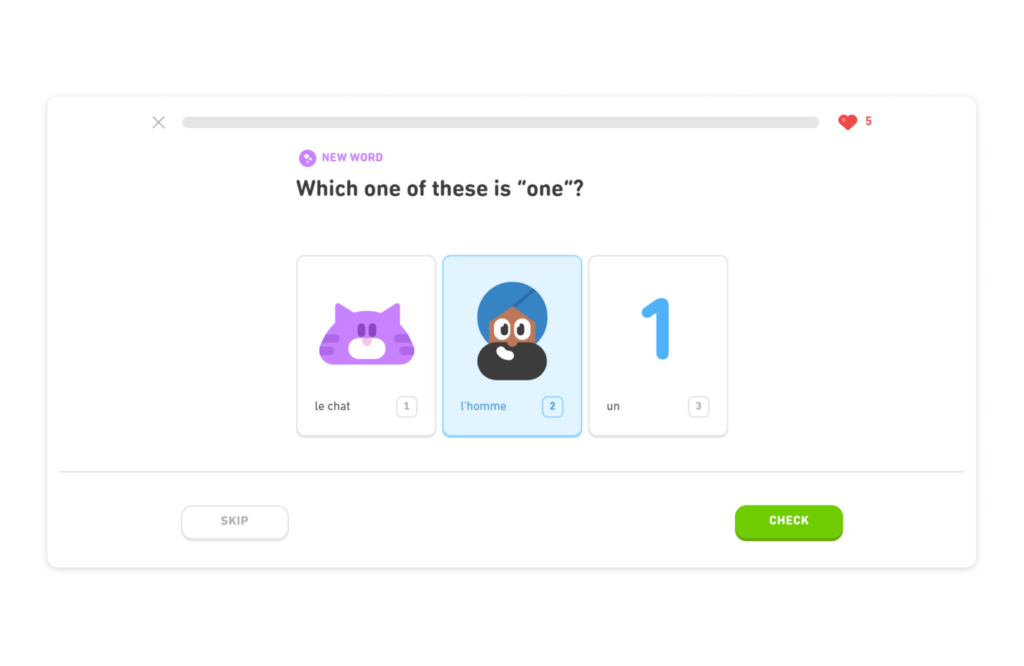
Each time you get a question correct, you’ll make progress on the progress bar, and earn points. By dishing out points for each task completed, users are encouraged to continue engaging with the app, helping them to finish the language lesson, reach the activation point, and go beyond it. This instant immersion and gamification process compels users to come back again and again.
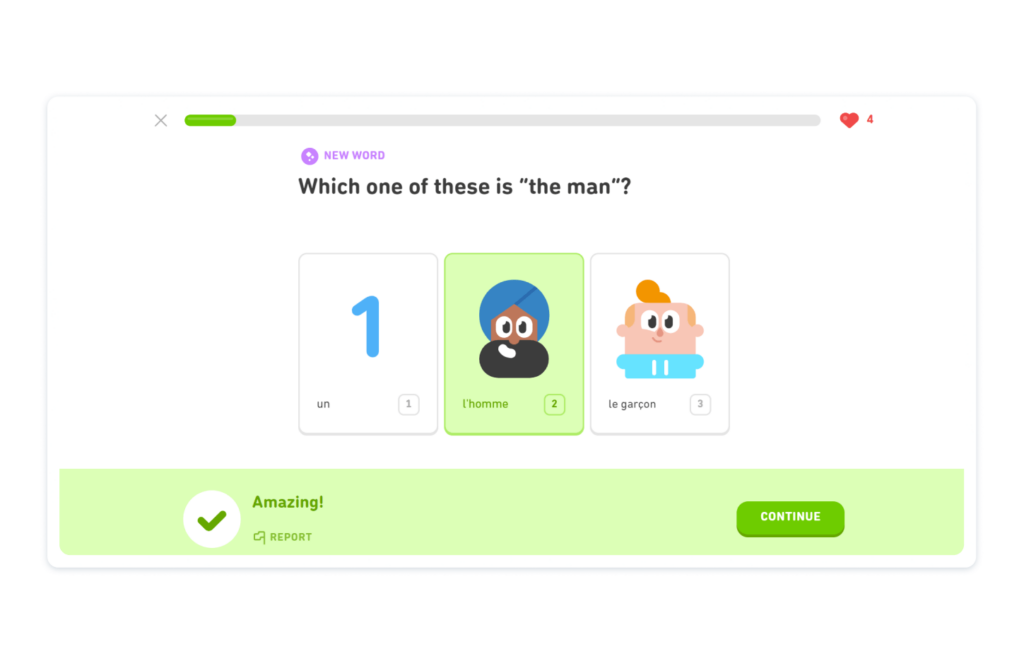
Dropbox
Dropbox uses the technique of interactive guides and education to get users to become activated. By onboarding the user with an interactive tutorial, users learn the value of the tool while engaging with it firsthand. When you first open up Dropbox, you’re encouraged to upload a file that you want to share.
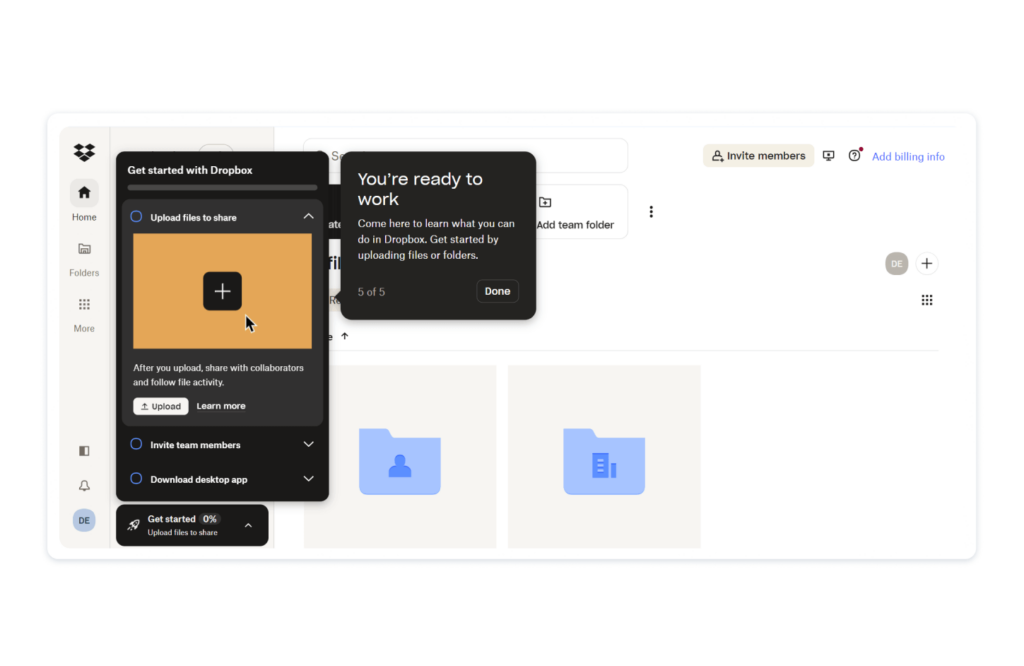
Once you’ve done that, it then shows you how to send it to anyone. This helps users reach the wow moment really quickly, as they understand how effective the tool can be at transferring files. This creates a really short Time to Value, which allows Dropbox to engage users quickly. This process allows the users to appreciate and experience the core value of the tool early on and it makes it easy for them to send their first file, achieving the activation criteria.
User metrics to measure alongside User Activation
When analyzing the success of your onboarding and how well you’ve attracted customers, you need to look at additional metrics to user activation to help you build a full picture of how your product is performing.
There are a lot of metrics that you can choose from—arguably too many—but as a starting point, make sure to check out both Adoption Rate and Time to Value.
- Adoption Rate: The number of users who are still engaging with your product after first signing up. You can also track feature adoption to see who’s still engaging with specific features within your product.
- Time to Value: how long it takes a user to achieve activation. The shorter the better as this shows that users are discovering the value of your product early on.
If you need support picking the right metrics that make sense to follow, we’ve got a helpful guide that lets you cut through the noise and focus on the metrics that matter for a Product Manager. Click the link below to download our complete list of Product KPIs.

Get active
User activation is a key metric when tracking the performance of your product. It gives you a clear picture of how many of your users have experienced the value that you offer firsthand. A good user activation rate demonstrates that your user onboarding is strong and that makes it more likely for these users to become key customers.
We understand the value of showing the benefits and core features of your product early to potential customers; that’s why we offer a sandbox environment for curious folk to try out ProdPad for themselves and discover why it can make you a better Product Manager. Why not have a go? We know you’ll love it.
Discover the value of ProdPad in our interactive sandbox environment.